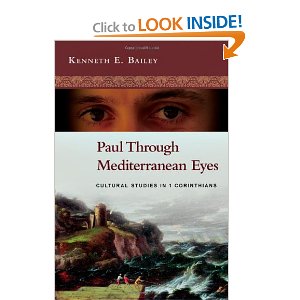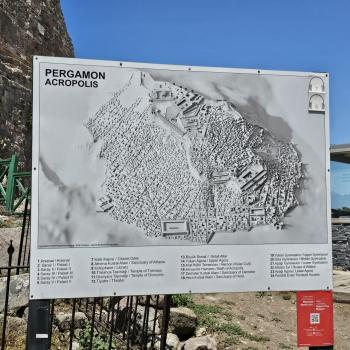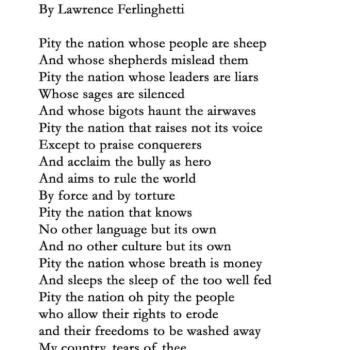The discussion of food offered to idols comprises one of the longer continuous discussions of Bailey (pp. 229-92), and it begins with his usual assertion that Paul starts out by citing a church tradition. This is not quite correct for it is not until 8.5-6 that we hear Paul recite the so-called Christian Shema where the term God is predicated of the Father and Lord of Jesus Christ, whereas in the OT Shema (Dt. 6.4) both the terms God and Lord refer to Yahweh. Bailey suggests at 8.6b that we follow the Arabic and Syriac rendering of ‘by whose hand are all things and we are by his hand’, but ‘through whom are all things, and we through him’ is better and earlier attested. The word ’hand’ is not attested early in this text.
Bailey’s discussion of the monotheistic affirmation is useful for those engaged in Christian-Muslim dialogue not least because as Bailey says about Sura 117 from the Koran which is the beginning of what is prayed 5 times a day by Muslims, the phrase ‘God is one’ in this Sura uses the Hebrew word for ‘one’ (ahad) rather than the Arabic word for one (wahad). This is likely because the composer of the Koran knew the Hebrew OT version of this basic monotheistic affirmation and drew on it. Bailey also suggests that Ps. 95.3-5 may stand behind the Christian Shema, since it mentions many gods, and the one true God or Lord who formed all things by his hands. This is possible, but what is more likely is the translators of the Arabic and Syriac versions of 1 Cor. 8.4-6 drew on the language of Ps. 95 and it affected the way they rendered the Corinthian text (importing the reference to God’s hand into it).
Bailey (p. 238) suggests that in 1 Cor. 8.4-6 we have Paul’s first reference to the pre-existence of Christ, Christ as the agent through whom God made creation. This is not quite correct because in 1 Cor. 1 Paul has already identified Christ as God’s Wisdom, and those who knew the figure discussed in Prov. 3, 8-9 would know that Wisdom was there with God helping in the fashioning of creation. These ideas about Wisdom, Paul predicates of Christ. This becomes even more explicit in 1 Cor. 10 when Paul makes the astounding claim— ‘and the rock was Christ’, which becomes a little less astounding when we realize that in Wisdom of Solomon it is said that Wisdom is the rock that gave water to the wilderness wandering generation. What earlier sapiential literature said about Wisdom, Paul applies to the pre-existent Christ.
Bailey rightly emphasizes that Paul wants to stress that knowledge without love puffs up and is not helpful. He quotes G.G. Findlay as saying “Knowledge operating alone makes it an engine of destruction” (p. 239). Sadly, one sees too much of this in the guild and Bailey even refers to the academic practice of children eating their parents— scholarly cannibalism, slicing and dicing and carving up the previous generation.
Bailey, like various commentators seems to think that Paul simply agrees with the strong in Corinth ‘that idols are nothing’. This however is not quite true. Paul is not arguing, ‘with better understanding one will realize that pagan deities are non-entities, they do not really exist’. No, as he will go on to say, it is ‘demons’ (daimonae) that lurk behind these conceptions and statues and religious practices, and for the Christian, they cannot partake of both the table of the Lord and the table of demons. In other words, pagan religion is not a paper tiger with no spiritual reality to conjure with. It is a false religion, involving spiritual realities that are harmful to humans.
One of the more interesting theories of Bailey is that the more evidence of care and rhetorical art in the composition of a passage in regard to the subject covered “the topic is thereby marked out by Paul as being extremely important” (p. 246). That is, the more complex the rhetorical structure, the more important the subject. It is not clear to me that this is always true. Bailey compares 1 Cor. 9.1-18 to Isaiah 44.1-5 and Jesus’ parable in Lk. 12.37-38, in terms of the structuring of things not the subject matter, in particular, what Bailey calls the sandwich technique (A B A). One has to say that this does not quite work with 1 Cor. 9.1-12. Paul does not mention his rights at the beginning of this discussion. It does not come until 9.3, and then again later at 9.12. So the discussion is not framed in this passage by mention of Paul’s rights. We have rhetorical questions about Paul’s identity in 9.1-2, not his rights as an apostle. And this also distinguishes this passage from the parable of Jesus, which does indeed refer the slaves blessing at vs. 37 and then again at 38b. Again the problem is that 1 Cor. 9 is probably too large and complex a unit for the audience to have caught the ring structure if there is one, which in this case does not appear to be quite the case. From time to time, even Bailey has to admit that the structure he proposes does not entirely work. For example, the phrase ‘in-lawed to Christ’ in 1 Cor. 9 does not suit the ring pattern Bailey thinks he discerns and so we have a footnote disclaimer “we noted extra material that was likely added after the original…was composed” (p. 254 n. 1). Alas, this could be said about almost all these ring compositions and they assume a lot of pre-composition before the composing of this letter. But the Greek of this letter does not suggest such a literary process. It suggests a document composed on the fly…. Complete with incomplete sentences at various junctures.
[‘No digging with the crown’= no using the Torah as a spade to make money—p. 248]
As Bailey rightly points out (p. 256) Paul does not actually say ‘to the Gentile I became a Gentile’ . He is says he became Jew and he says he became weak, and he says for Jews he lived under Torah and for non-Jews he lived outside Torah. Bailey’s explanation for why Paul does not say ‘to the Gentile I became a Gentile’ is because ethnically speaking, he can’t do that. He is a Jew! This is a good point, and reminds us that we need to pay strict and careful attention to the details of the Greek text, and not make assumptions based on assumed parallelisms which aren’t in the text. Of course this lesson needs to be heeded by Bailey as well.
On p. 259, Bailey says ‘the law of Christ’ is paralleled by Paul with the Torah of Moses, and suggests the former refers to the Jesus tradition.
This is at least partially correct, but this means that the phrase refers to something more than just having the mental outlook of Christ, or being loving like Christ, or being a servant like Christ etc. If it is in parallel with the Law of Moses and is called a Law, then it involves commandments. Earlier he had tried to suggest that while Paul uses imperatives, they have the force of the office who yells ‘shoot’ during target practice. If one fails to hit the target, says Bailey, there is no penalty. But in fact Paul suggests that the failure to obey Christ, and indeed even the failure to obey Paul’s imperatives does come with a price. This is clear in 1 Cor. 5-6 where he lists behavior which he has prohibited before which if persisted in can keep Christians out of the Kingdom.
On p. 263, Bailey suggests that if Paul grew up in Jerusalem, his native languages must have been Aramaic and Hebrew. While I would not want to dispute Paul knew those languages, Paul’s parents were from Tarsus, and spoke Greek, without much doubt. Greek would have been spoken in Paul’s home. If they moved to Jerusalem when Paul was young, or was a teen, perhaps for the sake of his further Jewish education in a Pharisaic mode (see Acts 22.3) then Greek was not a language Paul had to acquire. In any case, Jerusalem had long since been a mix-language milieu, including having synagogues where Greek speakers (Hellenists) could go. Paul may have been involved with them, hence his encounters with a Stephen. It is in any case a mistake to ignore the mixed language and multiple language milieu of Jerusalem in Paul’s day. It was a cosmopolitan place.
Bailey seems to miss the point (see pp. 270-72) of the analogy Paul draws with the experience of the wilderness wandering generation— namely that ‘their sacraments’ did not prevent their apostasy, and the Corinthians likewise would not be kept from falling just by participating in baptism or the Lord’s Supper. In other words, salvation was not guaranteed, or for that matter conveyed, through sacraments. Of course Paul knew that the crossing of the Red Sea was not really either a baptism (they didn’t get wet, or if they did, it was a sprinkling) or a sacrament. The point is to warn against the idolatry of immorality and the immorality of idolatry. Once again we find the problem of Bailey trying to squeeze a text into his Procrustean bed (made of rings instead of springs). When he gets to 10.13, since it doesn’t fit the ring pattern, he puts a parenthesis around it (p. 266) and calls it an aside or addendum or a footnote (p. 273). But an addendum or afterthought it surely is not. Indeed it is the crucial pastoral point of what he says here, to encourage the audience not to give up hope when they are tempted or tested and to remind them God is faithful.












